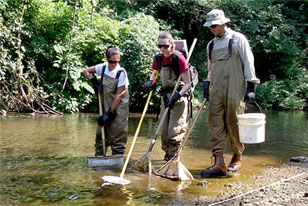American Eel Abundance: Recent Trends in Southeastern Pennsylvania

Introduction
The American eel (Anguilla rostrata) is a migratory species that spawns in the Atlantic, but spends most of its life in the streams, rivers, estuaries, and lakes of eastern North America. As they move from marine to estuarine and freshwater habitats, the eels transform from transparent glass eels to pigmented juveniles (elvers) and then to sexually immature adults called yellow eels. They spend a many as 20 years in this yellow-phase: feeding and growing until they’re ready to return to the ocean to spawn.
It’s important to understand the status and population trends of this commercially and ecologically significant species. The goals of this study is to re-sample historically-sampled sites to provide quantitative comparisons of abundance, and to assess eel abundance upstream and downstream of potential migration blocks (e.g., dams) in southeastern Pennsylvania.
Methods
American Eel Status
From 2007-2008, historic eel abundance data (from 1980-2001) were compiled from a variety of studies (e.g. PFBC, USGS, and ANSP stream survey data).
Historical data were subdivided by collection method and sampling season:
- Backpack electrofishing (single or multiple pass);
- Boat electrofishing;
- Habitat specific sampling (riffle, run, pool);
- Collection season (spring, summer, fall).
Historical sampling effort repeated in 2008 (see Study Sites for more detailed information on the 2008 study sites):
- Primarily backpack electrofishing 75-150 m reaches;
- Habitat assessment was repeated where historic reach habitat data were available.
YOY American Eel Movement
In 2008, seven stations on Ridley Creek, Pennsylvania, were sampled for YOY (young of the year) from March to August:
- One tidal and six non-tidal stations
- Repeated small area (75m2) backpack electrofishing conducted in 2007;
- YOY and 1+ eels differentiated by length and girth (1+ eels ≈ >10cm, YOY<10cm).
Sites for American Eel Status Study, 2008
Stations sampled in 2007 and 2008 to determine American Eel status
in southeastern Pennsylvania
| Station | Water Body | Subdrainage | Drainage | County |
|---|
| EWC |
East Branch
Wallenpaupack Creek |
Lackawaxen River |
Delaware River |
Wayne |
| BC |
Balliard Creek |
Shohola Creek |
Pike |
| SH |
Shohola Creek |
| 1 |
Delaware River |
Delaware River |
Northhampton |
| 2A |
Delaware River |
| KID |
Delaware River |
| KIP |
Delaware River |
| KIU |
Delaware River |
| DBH |
Delaware River |
| QAO |
Queen Anne Creek |
Mill Creek |
Bucks |
| PRN |
Pine Run |
Neshaminy Creek |
| PPF |
Pennypack Creek tribibutary |
Pennypack Creek |
Montgomery |
| PPO |
Pennypack Creek tribibutary |
| BVF |
Beaver Run |
Schuylkill River |
Chester |
| BVO |
Beaver Run |
| INF |
Indian Creek
of Cobbs |
Darby Creek |
Philadelphia |
| CC11 |
Cobbs Creek |
Delaware |
| CC6 |
Cobbs Creek |
| HP |
Darby Creek |
| DR |
Dismal Run |
Ridley Creek |
| RI11 |
Ridley Creek |
| RI12 |
Ridley Creek |
| RI14 |
Ridley Creek |
| RI15 |
Ridley Creek |
| RCF |
Rocky Run |
Chester Creek |
| MH1U |
Marcus Hook Creek |
Marcus Hook Creek |
| MH1L |
Marcus Hook Creek |
| MH2U |
Marcus Hook Creek |
| MH2L |
Marcus Hook Creek |
| MHJ1 |
Marcus Hook Creek |
| MHT1 |
Marcus Hook Creek |
| POM |
Pocopson Creek |
Christiana River |
Chester |
| WCM |
White Clay Creek |
| WCW |
White Clay Creek |
| MCC |
McCreary Run |
Octoraro Creek |
Susquehanna
River |
Lancaster |
| TW |
Octoraro Creek |
Chester |
| OC1 |
Octoraro Creek |
Results
We found few samples with quantitative eel data from before the 1990s, and uncertainties about sampling protocols impeded comparisons with these samples. Figures of historical stations able to re-sampled are shown below.
Tweed and McCreary Runs showed dramatic increases in both abundance and range of eel lengths (Figure 5 ). Seven dead American eels (>60 cm) were found downstream of dam in Octoraro Creek, a tributary to the Susquehanna River, suggesting turbine passage mortality.
Discussion
Increased abundance of American eels <30 cm in the most recent samples may be due to greater attention to sampling small eels or may reflect a resurgence in eel abundance possibly due to local and regional management actions.
Increased abundances of American eel in Tweed Run and McCreary Run appear to be due to a dam removal on Octoraro Creek, a tributary to the Susquehanna River.
The overall status of American eel abundance in southeastern Pennsylvania appears to have changed little in recent years (10-15 yrs) except where dam removal has increased upstream passage. Decreases in frequency of larger eels reflects the increased percentages of smaller eels in these samples.
In southeastern Pennsylvania in both this and other studies (2006-2007) we have found that YOY American eels move into areas near and above the head-of-tide in March and April. In May and June, abundances above the head-of-tide increase and by July (this study) some YOY have moved as much as 2 km upstream from the head-of-tide.
In southeastern Pennsylvania, YOY American eels appear to prefer sand-gravel substrate. The amount of sand-gravel substrate decreases with upstream movement and along with distance may be a limiting factor for upstream recruitment. In areas near the head-of-tide, small area (75m2) backpack electrofishing in late spring may be a suitable technique for monitoring YOY eels.
Acknowledgements
This work was conducted by Richard J. Horwitz, Paul F. Overbeck, David H. Keller and Shane M. Moser (ANSP). We thank the Pennsylvania State Wildlife Grants Program for sponsoring this study, Roger Thomas (ANSP) and Sylvan Klein (ANSP) for assisting with field work, Jerry Mead (ANSP) for assisting with map production, Gerry Waterfield (Normandeau), Mike Kaufmann (PFBC) and Robin Brightbill (USGS) for providing data.